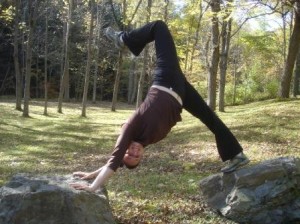This is from guest poster, Catherine. She’s a dedicated yogini and a new mom whose agreed to write a few guest posts for us here. I thought it would be great to get her perspective about life with an infant. Thank you Catherine!
———-
Uh Oh. I trust the Internet more than my pediatrician.
I have a big, healthy four-month-old son. Everything about him so far is very normal and average (which is great!) When I was pregnant, my belly would measure exactly on target for the week that I was in and I actually went into labor on his due date.
Given that I had such a low-risk pregnancy, I didn’t think much of the choice of his pediatrician. Around our 38th week, the midwife asked for the name of the pediatrician and my husband and I looked at each other as it dawned on us, “Oh, right. We should probably do that before he’s born.” Given that we were attempting to get 1000 other things done before he arrived, we went to the first pediatrician that we could find who was close to our house and covered by our insurance. We didn’t think much about the choice at the time. After ten minutes talking to the pediatrician, we thought she seemed like a very reasonable, knowledgeable woman.
And she DID turn out to be a reasonable, knowledgeable woman, but not the right pediatrician for us.
She wasn’t right for us for a few reasons. First of all, there was the Eye-Gunk Issue. From birth, my son would get mucus-y stuff in his eyes. It happened particularly when he slept, but occasionally at other times as well. For the first 6-7 weeks of his life it didn’t get worse or better, there was just always eye gunk in his eyes and I would wipe it away whenever I could with a warm washcloth. When it first started happening, I looked it up on the Internet (of course, right? Why go to a knowledgeable professional when you have Google?) and it seemed to simply be a clogged tear duct. All the sites say to just keep it clean and the tear duct will eventually open on its own. When we saw the pediatrician, however, she saw the eye gunk and prescribed erythromycin to rub on his eyes.
I said, “But is it an infection? Isn’t that an antibiotic?” She said, “No, it’s not an infection but this will clear it up.” I remained confused by her answer but after another week where the eye gunk level stayed the same, I decided to actually fill the prescription and start applying it. We had a messy several days of me trying to coat the inner eyelid of a baby with petroleum-based goo. He would then always rub his eyes with his hands and then of course stick them in his mouth. Being a new mom, I then became worried about him eating the eye goo. Since it didn’t seem to help the eye gunk issue, I simply stopped administering the goo and just didn’t tell our pediatrician. I just made sure that his eyes were nice and clean right before we went to see her. Now that he’s four months, the eye gunk issue is totally gone. Chalk one up for the Internet.
Next time I post I’ll write about another major issue – all about Vaccines.
